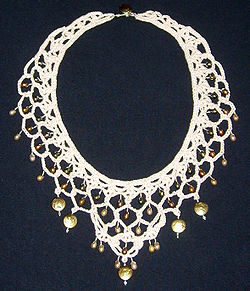- Cultured freshwater pearls
-
Freshwater pearls are a kind of pearl that comes from freshwater mussels. They are produced in Japan and the United States on a limited scale, but are now almost exclusive to China. The U.S. Federal Trade Commission requires that freshwater pearls be referred to as "freshwater cultured pearls" in commerce.
Contents
Current and historic industry
Although the Japanese freshwater pearl industry has nearly ceased to exist, it holds special historic value as the first country to cultivate whole freshwater pearls in Lake Biwa, using the Biwa pearly mussel (Hyriopsis schlegeli). The industry attempted a comeback with a mussel hybrid (Hyriopsis schlegeli/Hyriopsis cumingi) in Lake Kasumigaura in the last decade, but this venture also met with failure, with production ceasing in 2006. The pearl farm in Tennessee also holds special historic value as it is the only freshwater pearl outside of Asia, founded by the late John Latendresse, it continues as a tourist attraction. Today China is the only commercial producer of freshwater pearls, producing 1500 tons (2005) [1] using the triangle shell mussel (Hyriopsis cumingii) and several hybrids that have shown heterosis from several mussel species.
Grafting
A technician performing a grafting operation.
The grafting process begins by choosing a suitable donor mussel and cutting a strip of tissue from the mantle. This strip of tissue is then cut into three-millimetre squares. These squares are delivered to a technician who performs the operation. Unlike saltwater bead nucleation, this process is not considered difficult, and technicians need only minimum training to perform the operation. The technician creates small incisions on the upper valve, and inserts the tissue piece. A small twist of the tissue upon insertion is believed to create a higher ratio of round pearls. After the maximum number of grafts have been performed, the mussel is flipped, and the procedure is performed once again on the other valve of the shell.
Chinese freshwater mussels were once grafted up to 50 times per shell, or 25 times per valve. This practice was common when the industry mussel was primarily the cockscomb pearl mussel (Cristaria plicata). This mussel produced a high volume of low-quality pearls that came to be known as "Rice Krispie pearls" in the 1970s and 1980s. More than a decade ago the freshwater pearl industry of China shifted production from the cockscomb pearl mussel to the triangle shell mussel (Hyriopsis cumingii). The triangle shell produced fewer pearls, accepting only 12-16 grafts per valve for a total production of 24 to 32 pearls, but produced pearls of better quality.
Processing
Freshwater pearl harvests are typically bought while still in the shell. After harvest the pearls are delivered to a first-stage factory, which is responsible for cleaning and sorting the pearls by size and shape. After this process has been completed, the pearls are considered ready material for processing factories. The pearls are pre-treated (maeshori) in a warm and cold chemical solution and then bleached. The pearls that exhibit strong coloration will only go through the maeshori.
After the pearls are bleached they are drilled and then polished with a mixture of cornmeal and wax. Finally they are matched into temporary strands, which are then matched again into hanks. Hanks are composed of 5 to 10 temporary strands and are considered wholesale ready.
See also
- Fishing industry in China
- Agriculture in China
References
External links
Categories:- Gemstones
- Pearls
Wikimedia Foundation. 2010.

